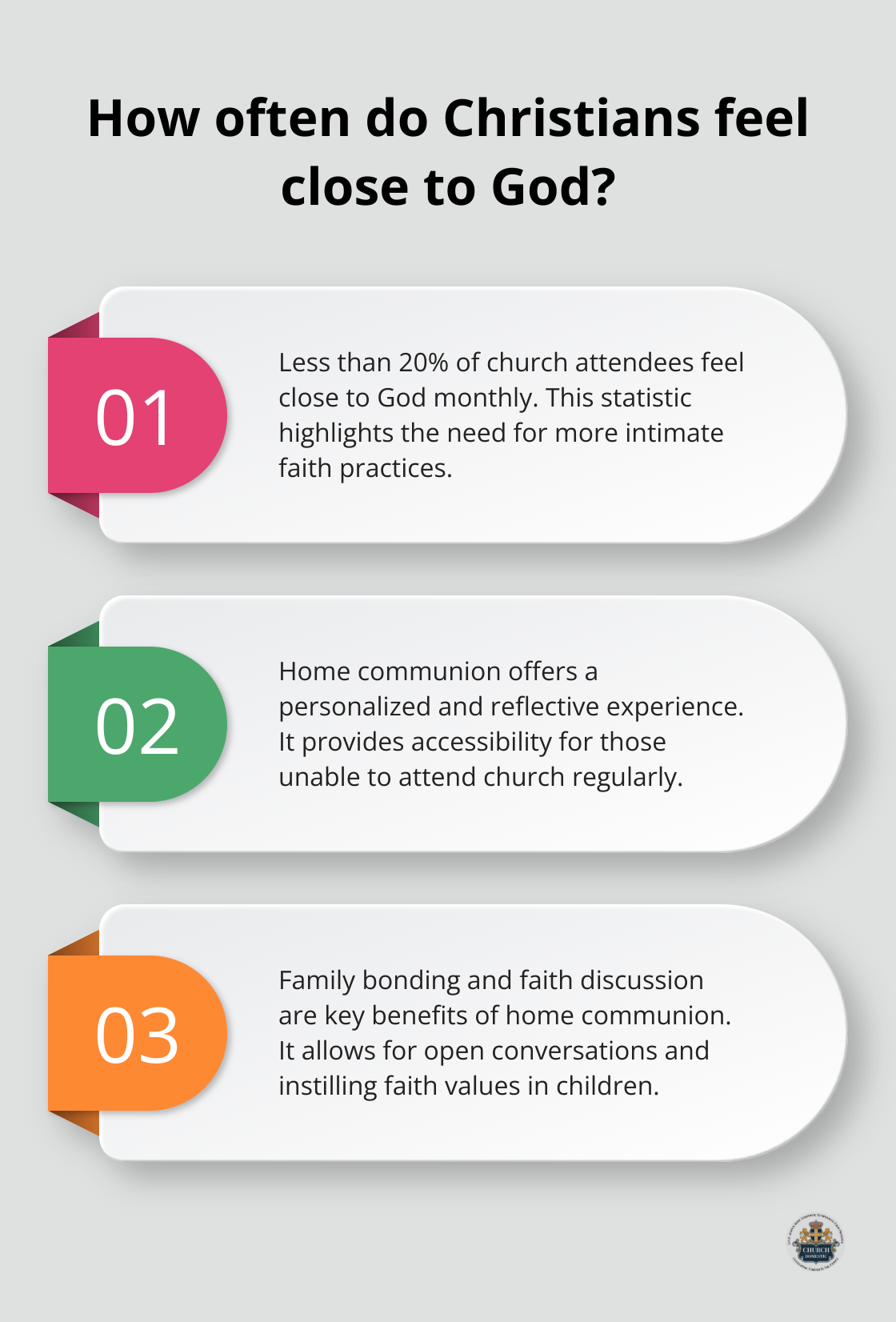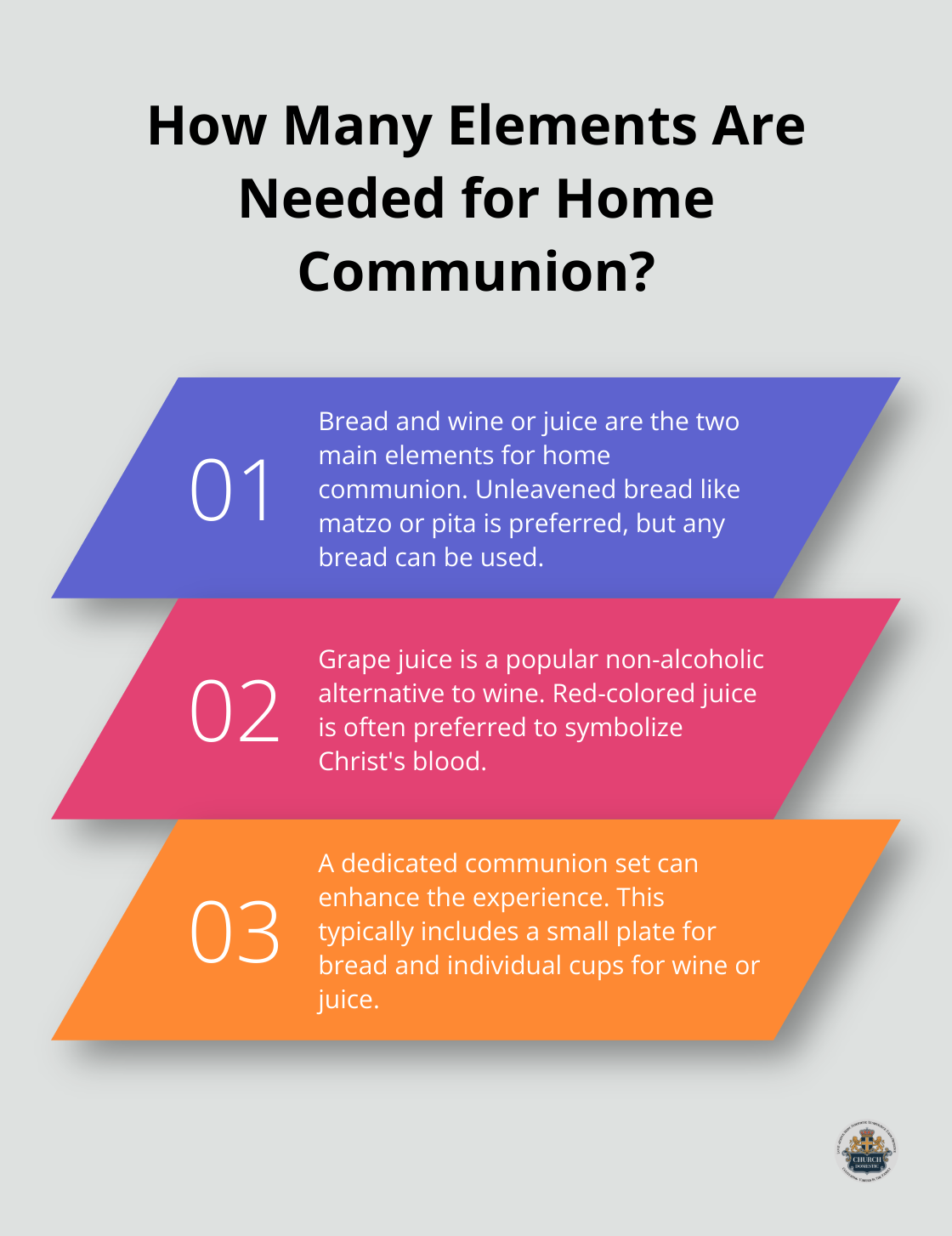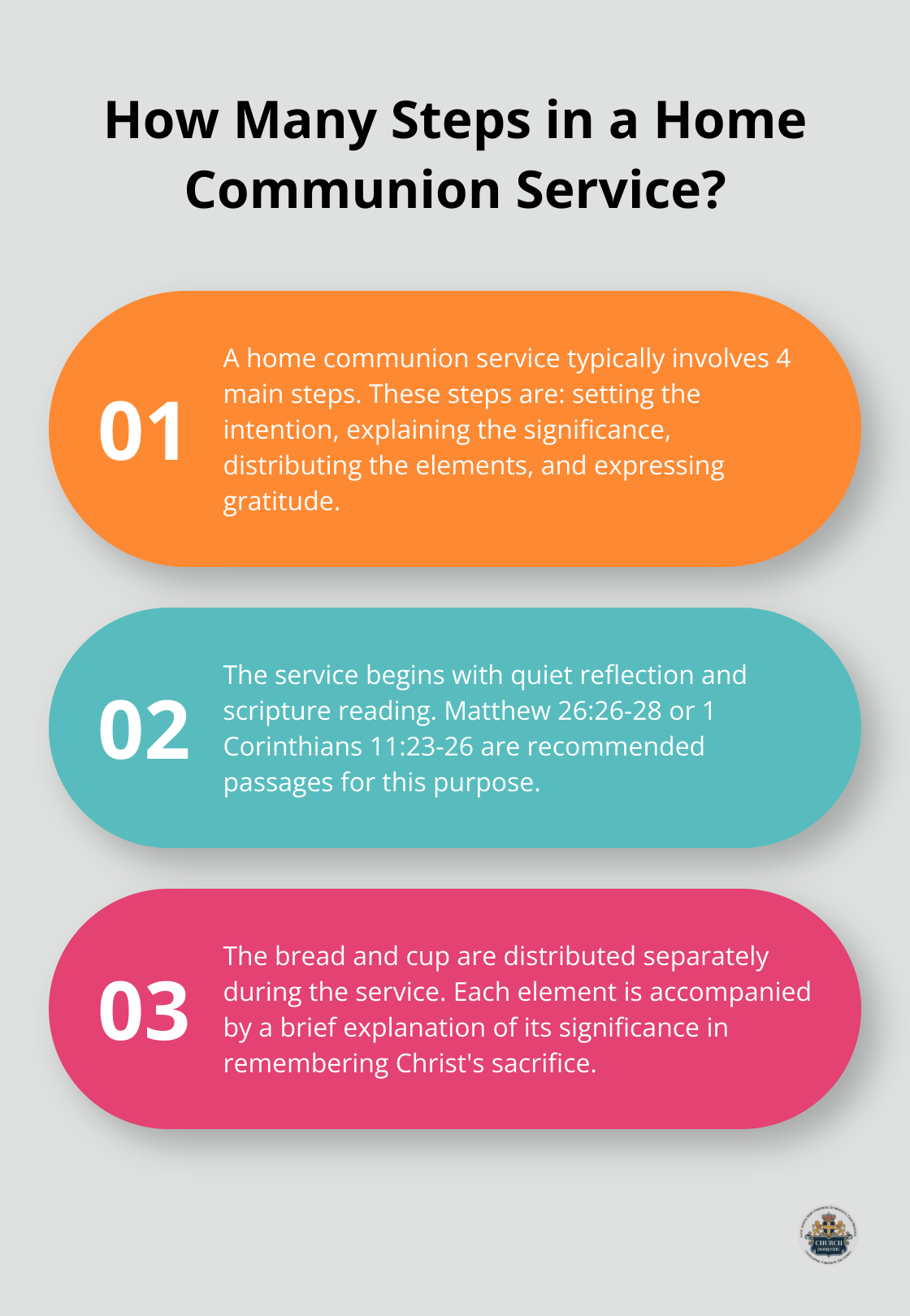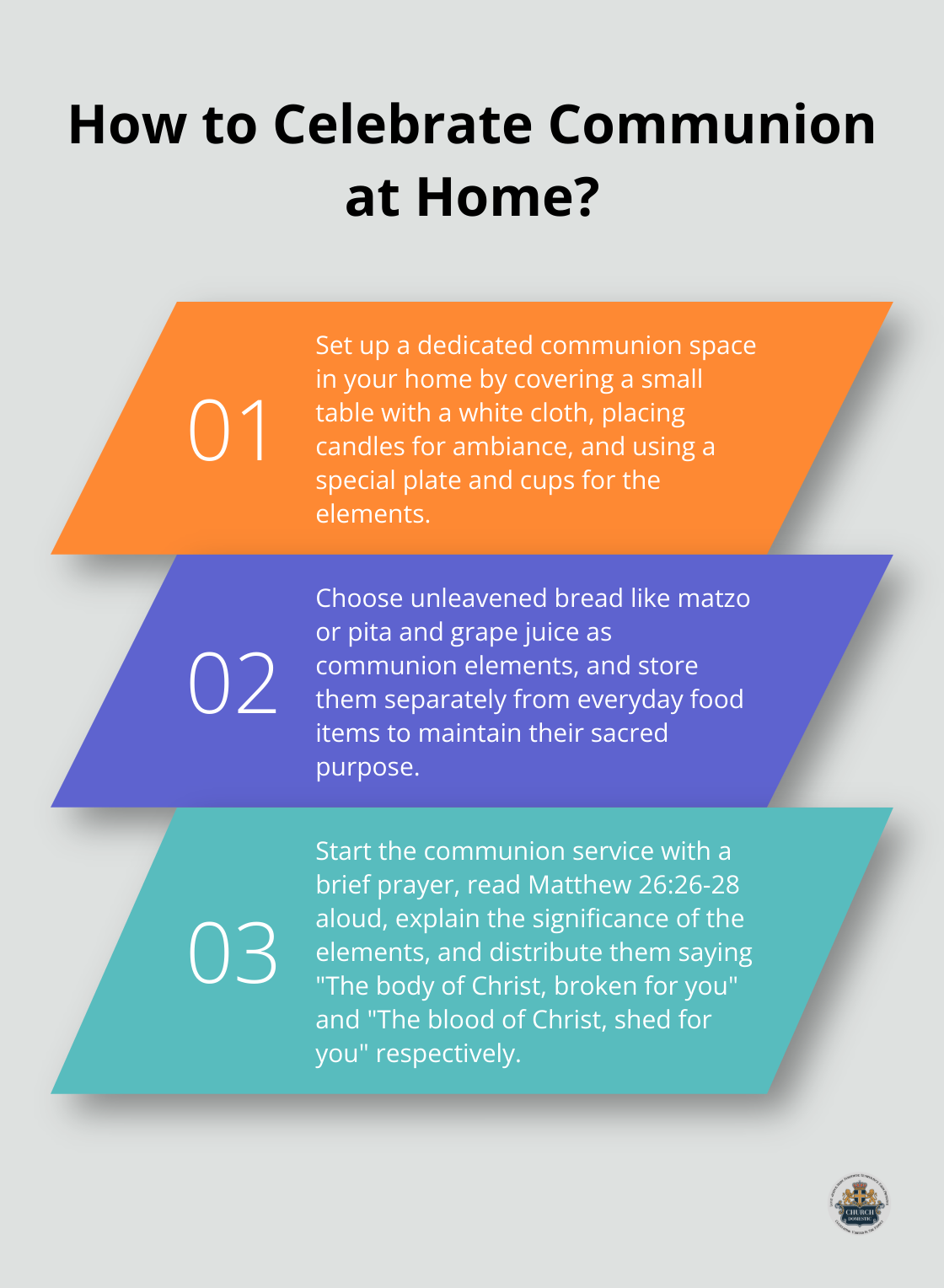At Church Domestic, we understand the deep significance of communion in the Christian faith. Many believers are now exploring ways to celebrate this sacred practice within their homes.
Home communion offers a unique opportunity to connect with God and reflect on His sacrifice in a personal setting. In this guide, we’ll walk you through the steps to create a meaningful communion experience right where you live.
Why Home Communion Matters
The Biblical Foundation
Communion, also known as the Lord’s Supper or Eucharist, stands as a cornerstone of Christian faith. Its origins trace back to Jesus’ last meal with his disciples, where he instructed them to remember him through bread and wine. For centuries, this practice has remained central to Christian worship, typically observed in church settings. However, the concept of home communion now gains traction, offering a unique and intimate way to connect with God.

The Bible provides a clear basis for communion. In 1 Corinthians 11:23-26, Paul recounts Jesus’ words at the Last Supper, emphasizing the importance of this practice in remembering Christ’s sacrifice. Jesus himself encouraged his followers to partake in this ritual “as often as you drink it” (1 Corinthians 11:25), suggesting flexibility in its frequency and setting.
Deepening Faith Through Intimate Practice
Communion transcends mere ritual; it serves as a powerful tool for spiritual growth. It provides a tangible way to reflect on Jesus’ sacrifice and its implications for our lives. Regular participation can enhance our understanding of grace, forgiveness, and our relationship with God. However, it’s important to note that a study found that less than 20% of people who attend church actually feel close to God on even a monthly basis.
The Unique Benefits of Home Communion
Celebrating communion at home offers several distinct advantages:
- Personalized Experience: It allows for a more reflective experience, free from the time constraints often present in church services.
- Accessibility: Home communion can be particularly meaningful for those unable to attend church regularly (due to health issues, work schedules, or other constraints).
- Family Bonding: It provides an opportunity for families to discuss faith openly, ask questions, and share insights in a comfortable environment. This can be especially valuable for parents looking to instill faith values in their children.
- Crisis Adaptation: In times of crisis or social distancing (such as during the COVID-19 pandemic), home communion ensures that believers can maintain this aspect of their faith practice.
Integrating Faith into Daily Life
Home communion creates a bridge between our everyday lives and our spiritual beliefs. It reminds us that our faith is not compartmentalized but integrated into every aspect of our lives. Nurturing faith within the home environment proves essential for spiritual growth and family unity.
As we move forward, let’s explore how to prepare for a meaningful home communion experience, ensuring that this sacred practice becomes a regular part of your spiritual journey.
How to Prepare for Home Communion
Selecting the Right Elements
The bread and wine (or juice) used in communion carry deep symbolic meaning. For bread, select unleavened varieties like matzo or pita to align closely with biblical tradition. If these aren’t available, any bread will suffice. The key is to choose something that feels special and set apart for this purpose.

For the cup, grape juice serves as a popular non-alcoholic alternative to wine, especially in households with children or those avoiding alcohol. If grape juice isn’t available, any juice can work. The color red is often preferred to symbolize Christ’s blood, but it’s not mandatory.
Consider purchasing a dedicated communion set for your home. This could include a small plate for the bread and individual cups for the wine or juice. While not necessary, having special items can enhance the sense of reverence during the ceremony.
Creating a Sacred Space
To create a sacred space in your home, you don’t need elaborate decorations. The goal is to minimize distractions and foster an atmosphere of reverence. Choose a quiet area of your home, free from clutter and noise. A simple table covered with a clean white cloth can serve as your communion altar.
Lighting creates a reflective ambiance, with candles signifying the light of Christ or the presence of the Holy Spirit. If you have a cross or other meaningful religious symbols, consider incorporating them into your setup.
Background music can enhance the experience. Choose instrumental hymns or soft worship music to play quietly in the background. Alternatively, silence can be powerful, allowing for deeper reflection.
Involving Others in the Experience
While communion can be a solitary practice, sharing it with others can deepen its impact. Invite family members to participate, explaining the significance to younger children. This can be an excellent opportunity for faith discussions and bonding.
If you live alone or wish to expand your circle, consider forming a small group with friends or neighbors. You could rotate hosting duties or meet virtually if in-person gatherings aren’t possible.
When inviting others, be clear about expectations. Provide guidance on dress code (if any), what to bring (if anything), and the general structure of your communion service. This helps everyone feel prepared and comfortable.
The heart of communion lies not in perfect execution but in sincere remembrance and gratitude. As you prepare, focus on creating an experience that draws you and your loved ones closer to God and each other. With these preparations complete, you’re ready to conduct a meaningful home communion service. Let’s explore how to lead this sacred practice in the next section.
Leading a Meaningful Home Communion Service
Set the Intention
Start your communion service with a moment of quiet reflection. This helps everyone transition from daily activities to a sacred mindset. A simple prayer can set the tone. For example: “Lord, we gather here to remember Your sacrifice and celebrate Your love. Open our hearts to Your presence.”

Next, read a relevant scripture passage. Matthew 26:26-28 or 1 Corinthians 11:23-26 are excellent choices. Reading aloud engages everyone present and grounds the service in biblical truth.
Explain the Significance
Before you distribute the elements, take time to explain their significance. This is especially important if children or newcomers are present. Keep it simple and heartfelt. You might say:
“This bread represents Christ’s body, broken for us. As we eat it, we remember His sacrifice and the new life it brings us.”
“This cup represents Christ’s blood, shed for the forgiveness of our sins. As we drink, we celebrate the new covenant He established with us.”
Encourage participants to reflect silently on what Christ’s sacrifice means to them personally.
Distribute the Elements
Distribute the bread first. If you lead the service, you might serve others before taking your own portion. As you share the bread, you can say, “The body of Christ, broken for you.”
After everyone has received the bread, eat together. Allow a moment of silence for reflection.
Next, distribute the cups in the same manner, saying, “The blood of Christ, shed for you.” Drink together, again followed by a moment of quiet contemplation.
Express Gratitude
End your service with a prayer of thanksgiving. Invite participants to share brief thoughts or insights if they feel comfortable. This can deepen the communal aspect of the experience.
A closing prayer might include:
“Thank you, Lord, for this time of remembrance and renewal. May the truth of Your sacrifice impact our daily lives. Help us to live in light of Your love and grace. Amen.”
The power of communion lies not in perfect execution but in sincere hearts turned towards God. As you practice home communion regularly, you’ll likely develop a rhythm that feels natural and meaningful for your household or group (this can take time, so be patient with yourself and others).
Final Thoughts
Home communion offers a powerful way to deepen personal faith and strengthen connections with God. This sacred practice in our homes creates opportunities for intimate reflection, family bonding, and spiritual growth. The act of remembering Christ’s sacrifice in our daily environment reminds us of His love and presence in our lives.

We encourage you to make home communion a regular part of your spiritual routine. Consistency helps build a meaningful practice, and you’ll likely find that the experience becomes richer and more impactful over time. Don’t feel discouraged if it feels awkward at first – like any spiritual discipline, it takes time to develop a natural and profound rhythm.
At Church Domestic, we believe that integrating faith into everyday life is essential for spiritual growth and family well-being. Home communion is just one way to bring sacred practices into your domestic sphere. We invite you to explore more resources and ideas on our website to help you cultivate a rich, faith-filled home life.